Numerical Simulation and Wind Tunnel Test of a Variable Geometry Auxiliary Inlet for a Wide-Body Aircraft Environmental Control System
Abstract
:1. Introduction
2. Methods
2.1. Geometric Model
2.2. Grid Generation and Boundary Conditions
2.3. Grid Independence Verification
2.4. Numerical Simulation Scheme
2.5. Analysis of Numerical Simulation Results
2.5.1. Pressure Counters
2.5.2. Roll-Up Vortices
3. Wind Tunnel Test
3.1. Test Model and Equipment
3.2. Data Measurement
3.3. Repeatability Test
4. Analysis of Test Results
4.1. Comparison of Simulation Results and Test Results
4.2. Total Pressure Recovery Coefficient versus Mass Flow Rate
4.3. Pressure Rise Ratio versus Mass Flow Rate
4.4. Flow Coefficient versus Opening
5. Conclusions
- (a)
- The favorable pressure gradient and the roll-up vortices are the major impetus that inhales the incoming flow into the inlet;
- (b)
- When the mass flow rate is constant, with the increase in the opening, the total pressure recovery coefficient gradually increases, reaching the maximum value at 50% opening. Then, the total pressure recovery coefficient begins to decline as the opening continues to increase;
- (c)
- The relationship between flow coefficient and opening is not monotonous. When the opening exceeds 70%, the flow coefficient will decrease with the increase in the opening. The higher the Mach number, the more obvious the decreasing trend;
- (d)
- When the mass flow rate is constant and the opening is less than 50%, the larger the opening, the larger the pressure rise ratio. However, when the opening exceeds 50%, the pressure rise ratio begins to decline at this time.
Author Contributions
Funding
Institutional Review Board Statement
Informed Consent Statement
Data Availability Statement
Conflicts of Interest
References
- Shou, R.Z.; He, H.S. Environment Control for Aircraft, 1st ed.; Beijing University Press: Beijing, China, 2004. [Google Scholar]
- Wang, Y.; Li, Z.M.; Pei, H.J.; Cui, Y.L.; Chen, C.D. Research advances of ram air intake of civil aircraft. Aviat. Precis. Manuf. Technol. 2020, 5, 31–35, 39. [Google Scholar]
- Huang, G.; Saheby, E.B.; Hays, A. Propulsive efficiency of ridge/inlet configuration. Int. J. Aerosp. Eng. 2018, 2018 Pt 2, 7462024.1–7462024.17. [Google Scholar] [CrossRef]
- Wang, L.M. Research on aerodynamic performance simulation and flow control on the submerged inlet by considering the influence propeller slipstream flow. Adv. Aeronaut. Sci. Eng. 2020, 11, 664–671. [Google Scholar]
- Huang, H.X.; Tan, H.J.; Lin, Z.K.; Li, Z.J.; Sun, S.; Chen, H.; Xiao, Z.X. Flowfield of a helicopter submerged inlet with power output shaft. Acta Mech. Sin. 2021, 37, 156–168. [Google Scholar] [CrossRef]
- Xie, W.Z.; Yang, S.Z.; Zeng, C.; Liao, K.; Ding, R.H.; Zhang, L.; Guo, S. Effects of forebody boundary layer on the performance of a submerged inlet. Aeronaut. J. 2021, 125, 1260–1281. [Google Scholar] [CrossRef]
- Taskinoglu, E.S.; Knight, D. Numerical analysis of submerged inlets. In Proceedings of the 20th AIAA Applied Aerodynamics Conference, St. Louis, MO, USA, 24–26 June 2002. [Google Scholar]
- Sun, S.; Guo, R.W. Characterization and performance enhancement of submerged inlet with flush-mounted planar side entrance. J. Propuls. Power 2007, 23, 987–995. [Google Scholar] [CrossRef]
- Wang, P.C.; Zhang, H.Y.; Sun, S.; Wang, J.F.; Cheng, K.M. Experimental study of flow characteristics of inlet/internal flowpath for a hypersonic flight vehicle. J. Aerosp. Power 2007, 22, 1704–1709. [Google Scholar]
- Jiao, Z.H.; Deng, F.; Fang, Y.; Liu, H.; Chen, J. Integrated design and test of forebody/inlet for air-breathing hypersonic vehicle. J. Aerosp. Power 2017, 32, 168–176. [Google Scholar]
- Fang, J.; Zheng, Q.G.; Cai, C.P.; Zhang, H.B. Maneuver control at high angle of attack based on real-time optimization of integrated aero-propulsion. Chin. J. Aeronaut. 2022, 35, 173–188. [Google Scholar] [CrossRef]
- Zuo, F.Y.; Molder, S.; Chen, G. Performance of wavecatcher intakes at angles of attack and sideslip. Chin. J. Aeronaut. 2021, 34, 244–256. [Google Scholar] [CrossRef]
- Jin, Y.; Sun, S.; Tan, H.J.; Zhang, Y.; Huang, H. Flow response hysteresis of throat regulation process of a two-dimensional mixed-compression supersonic inlet. Chin. J. Aeronaut. 2022, 35, 112–127. [Google Scholar] [CrossRef]
- Frick, C.W.; Davis, W.F.; Randall, L.M.; Mossman, E.A. An Experimental Investigation of NACA Submerged-Duct Entrances; NACA ACR-5120; National Advisory Committee for Aeronautics: Washington, DC, USA, 1945. [Google Scholar]
- Delany, N.K. An Investigation of Submerged Air Inlets on a 1/4-Scale Model of a Fighter-Type Airplane; NACA RM-A8A20; National Advisory Committee for Aeronautics: Washington, DC, USA, 1948. [Google Scholar]
- Frank, J.L. Pressure-Distribution and Ram-Recovery Characteristics of NACA Submerged Inlets at High Subsonic Speeds; NACA-RM-A5OE02; National Advisory Committee for Aeronautics: Washington, DC, USA, 1950. [Google Scholar]
- Hall, C.F.; Barclay, F.D. An experimental investigation of NSIs at high subsonic speeds I: Inlets forward of the wing leading edge. In Technical Report Archive & Image Library; National Advisory Committee for Aeronautics: Washington, DC, USA, 1948. [Google Scholar]
- Yang, Z.Y. Large-eddy simulation: Past, present and the future. Chin. J. Aeronaut. 2015, 28, 11–24. [Google Scholar]
- Francesco, D.V.; Giacomo, B.; Francesco, P.; Ernesto, B. Effect of convective schemes in wall-resolved and wall-modeled LES of compressible wall turbulence. Comput. Fluids 2023, 250, 105710. [Google Scholar]
- Francesco, D.V.; Matteo, B.; Francesco, P.; Ernesto, B. Wall-modeled LES of shock-wave/boundary layer interaction. Int. J. Heat Fluid Flow 2022, 98, 109071. [Google Scholar]
- Schlatter, P.; Örlü, R. Assessment of direct numerical simulation data of turbulent boundary layers. J. Fluid Mech. 2010, 659, 116–126. [Google Scholar] [CrossRef]
- Li, S.; Paoli, R. Modeling of ice accretion over aircraft wings using a compressible OpenFOAM solver. Int. J. Aerosp. Eng. 2019, 2019, 4864927. [Google Scholar] [CrossRef]
- Liu, C.; Pei, H.J.; Chen, C.D.; Xu, W.B.; Yang, K.J. Effects of geometric parameters on performance of rectangular submerged inlet for aircraft. Trans. Nanjing Univ. Aeronaut. Astronaut. 2021, 38, 984–992. [Google Scholar]
- Chen, C.D.; Pei, H.J.; Wu, B.Y. Study on data-driven prediction model of air inlet performance of aircraft NACA. Aer. Comput. Technol. 2020, 50, 71–75. [Google Scholar]
- Pei, H.J.; Cui, Y.L.; Kong, B.B.; Jiang, Y.L.; Shi, H. Structural parameters optimization of submerged inlet using least squares support vector machines and improved genetic algorithm-particle swarm optimization approach. Eng. Appl. Comput. Fluid Mech. 2021, 15, 503–511. [Google Scholar] [CrossRef]
- Li, Z.M.; Chen, C.D.; Pei, H.J.; Kong, B.B. Structural optimization of the aircraft NACA inlet based on BP neural networks and genetic algorithms. Int. J. Aerosp. Eng. 2020, 2020, 8857821. [Google Scholar] [CrossRef]
- You, M.; Dai, L.; Li, D.W. Variable geometry inlet control research for hypersonic aircraft. Aircr. Des. 2023, 43, 23–28. [Google Scholar]
- Liu, Y.; Xie, L.R.; Wang, K. Design and performance analysis for three types of two-dimension variable supersonic inlets. J. Chongqing Univ. Technol. Nat. Sci. 2018, 32, 67–75. [Google Scholar]
- Wang, X. Research on a Two-Dimensional Variable Geometry Supersonic Inlet; Nanjing University of Aeronautics and Astronautics: Nanjing, China, 2019. [Google Scholar] [CrossRef]
- Mossman, E.A.; Randall, L.M. An experimental investigation of the design variables for NACA submerged duct entrances. In Technical Report Archive & Image Library; National Advisory Committee for Aeronautics: Washington, DC, USA, 1948. [Google Scholar]
- Zhang, T.Y.; Sun, Z.; Sun, J.H.; Zhang, S.Y.; Xu, C.Y. Numerical simulation of flow field in ram air inlet duct with ejetor. J. Nanjing Univ. Aeronaut. Astronaut. 2019, 51, 486–492. [Google Scholar]
- Maghsoudi, I.; Vaziry, M.A.; Mahmoodi, M. Experimental investigation of flow and distortion mitigation by mechanical vortex generators in a coupled serpentine inlet-turbofan engine system. Chin. J. Aeronaut. 2020, 33, 5–21. [Google Scholar] [CrossRef]
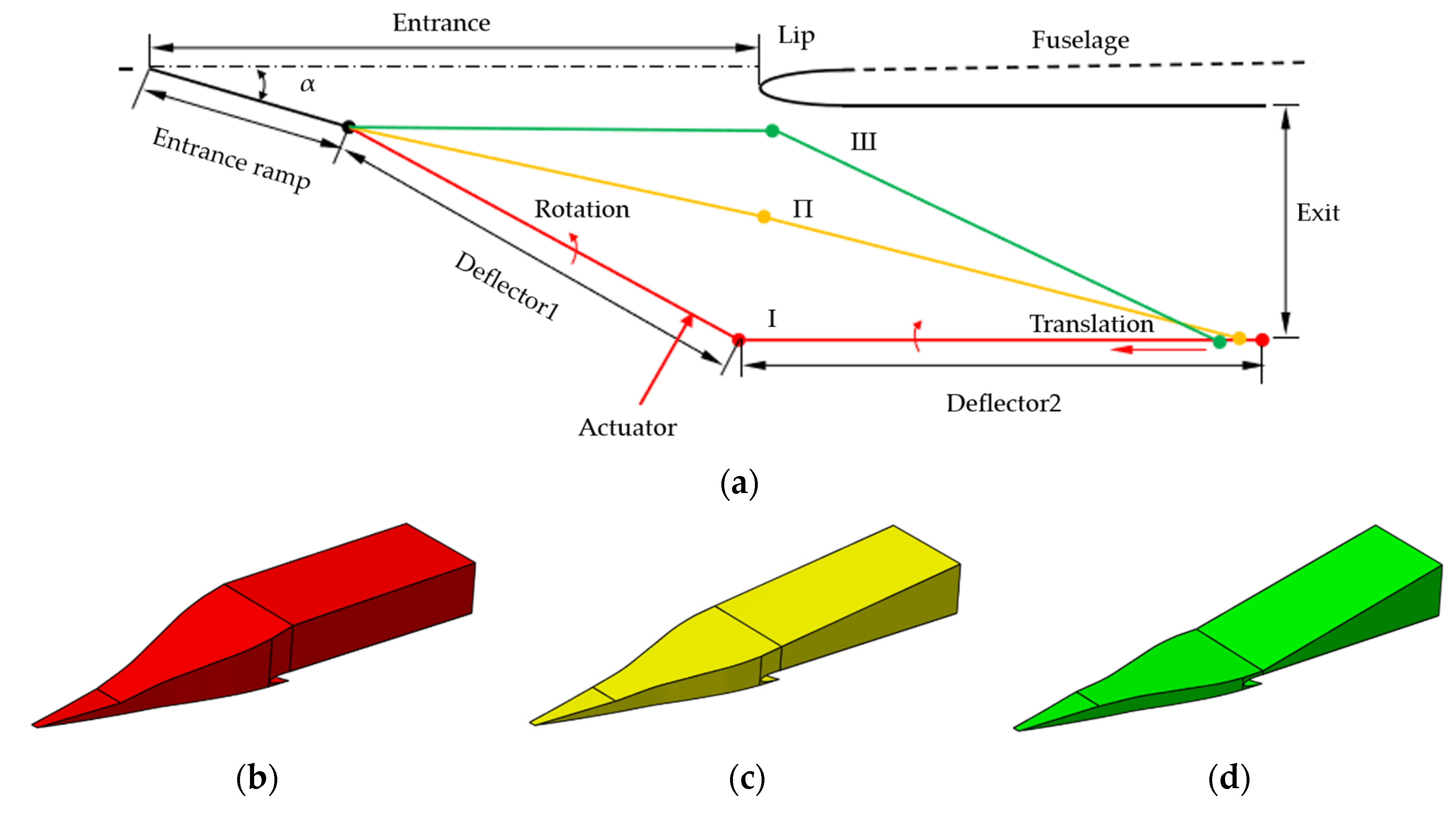

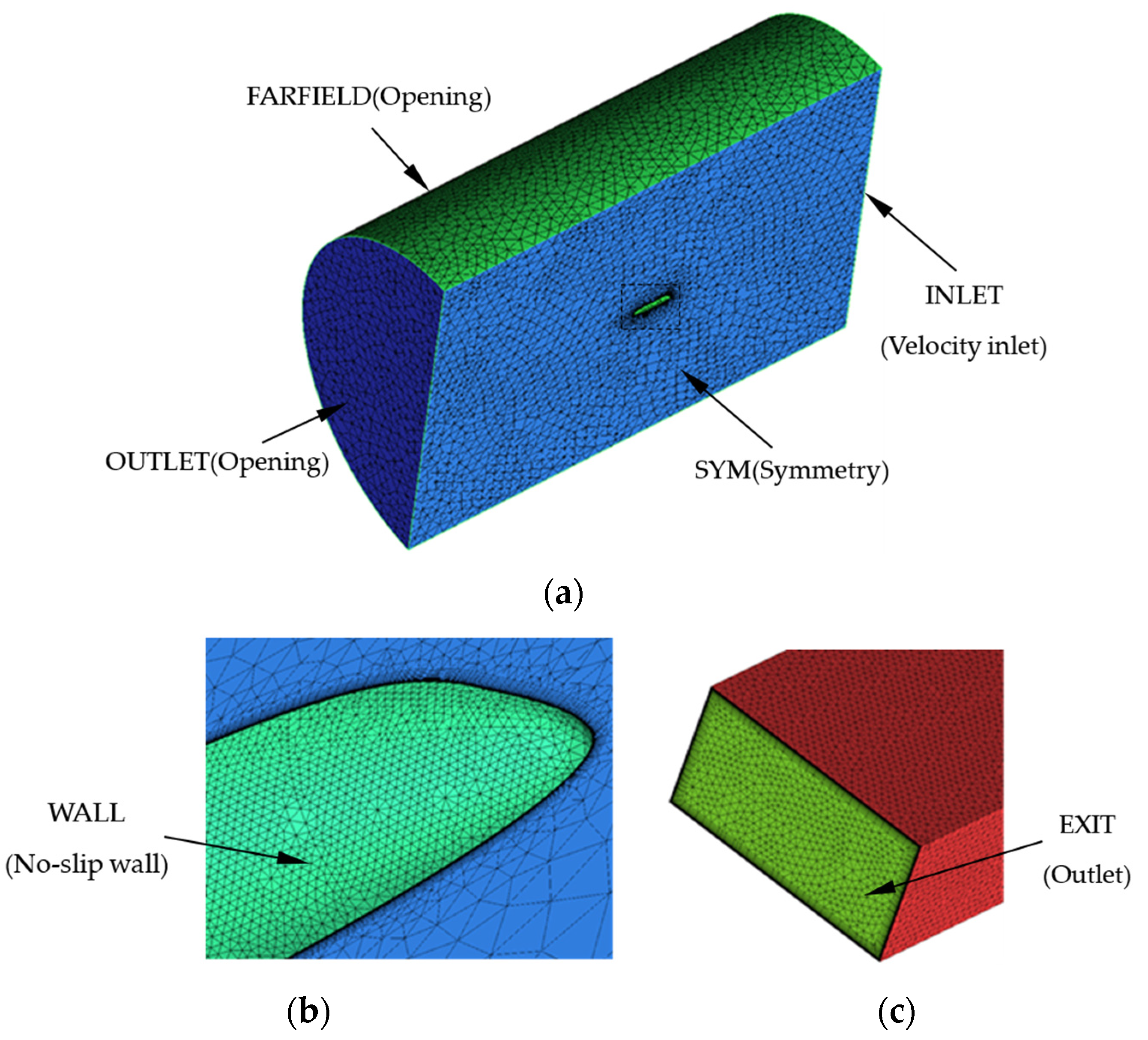
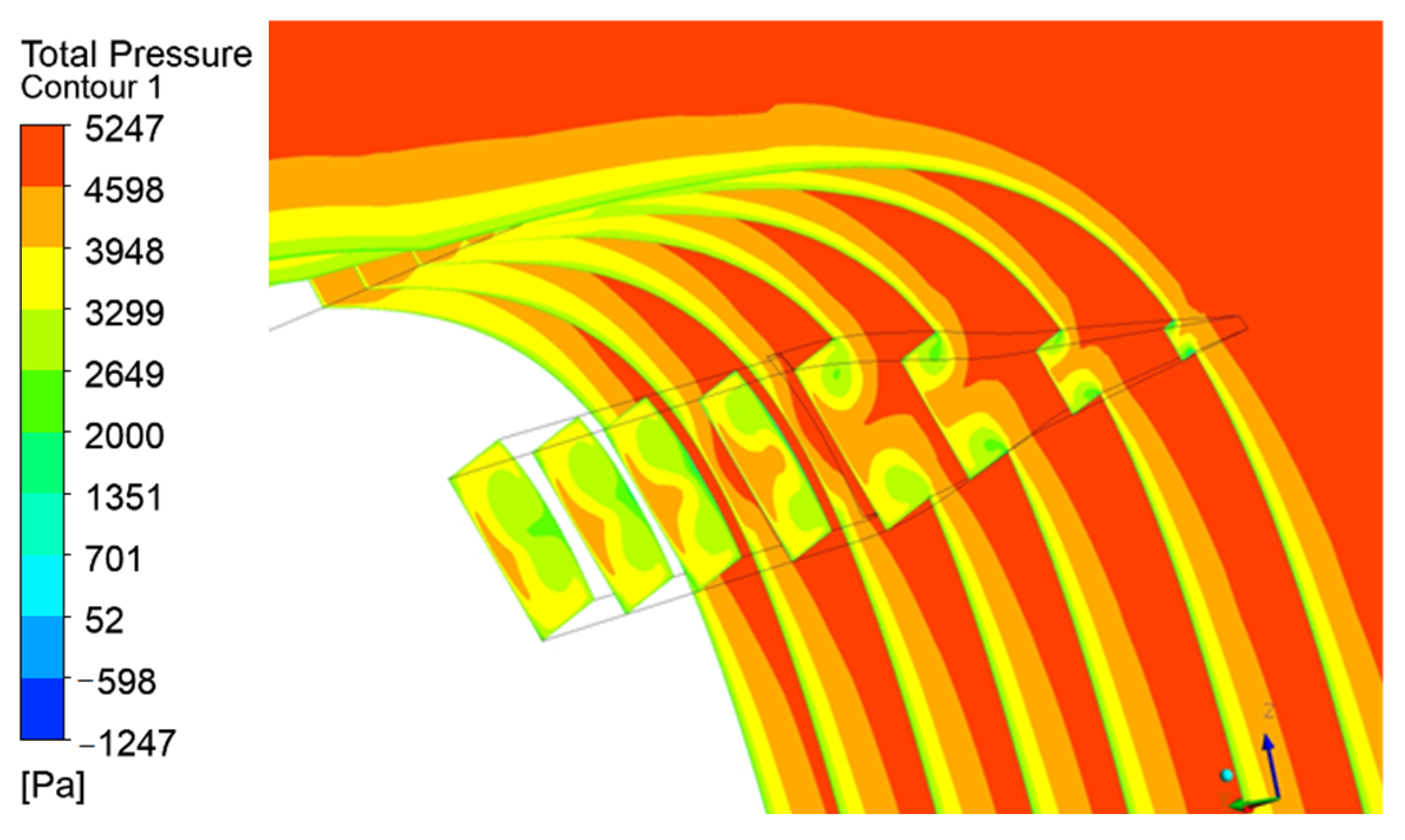
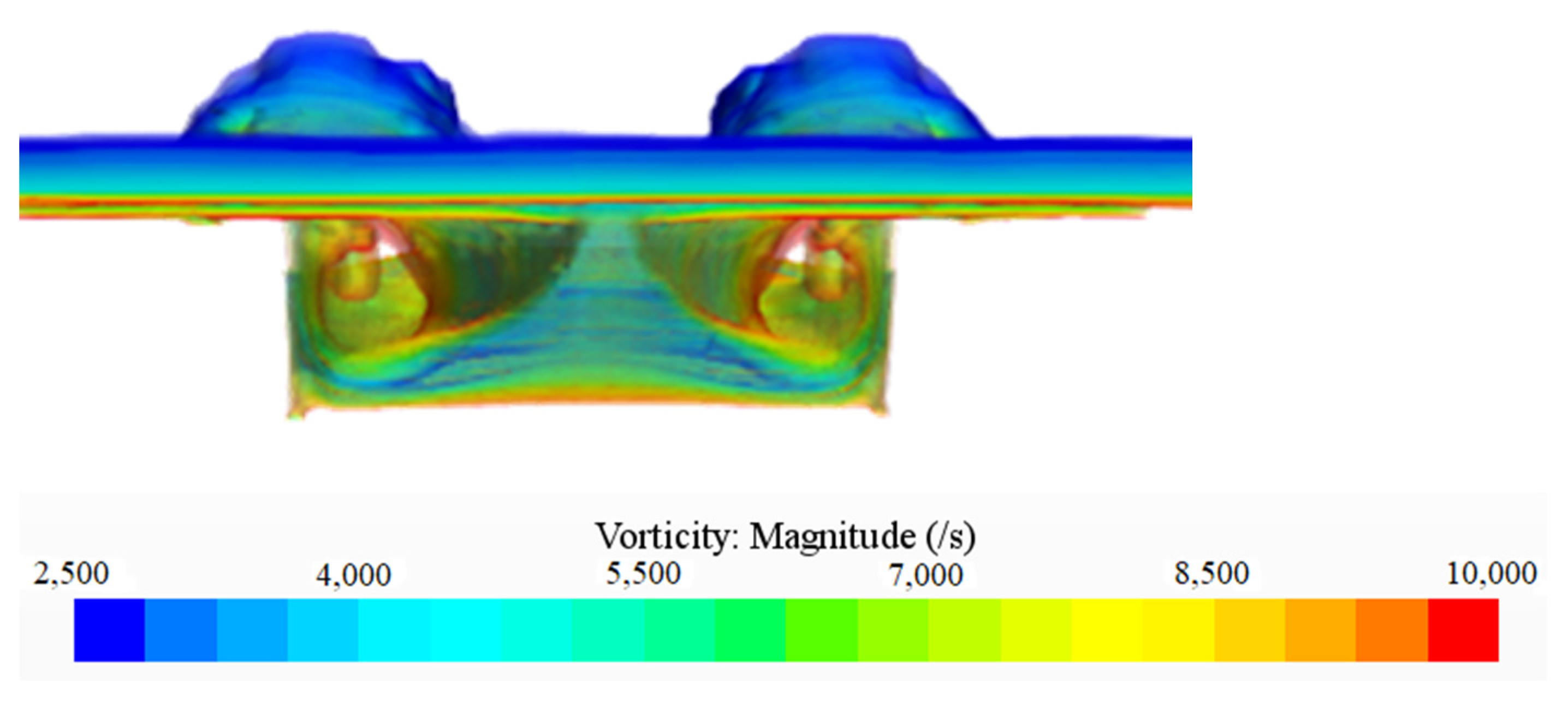

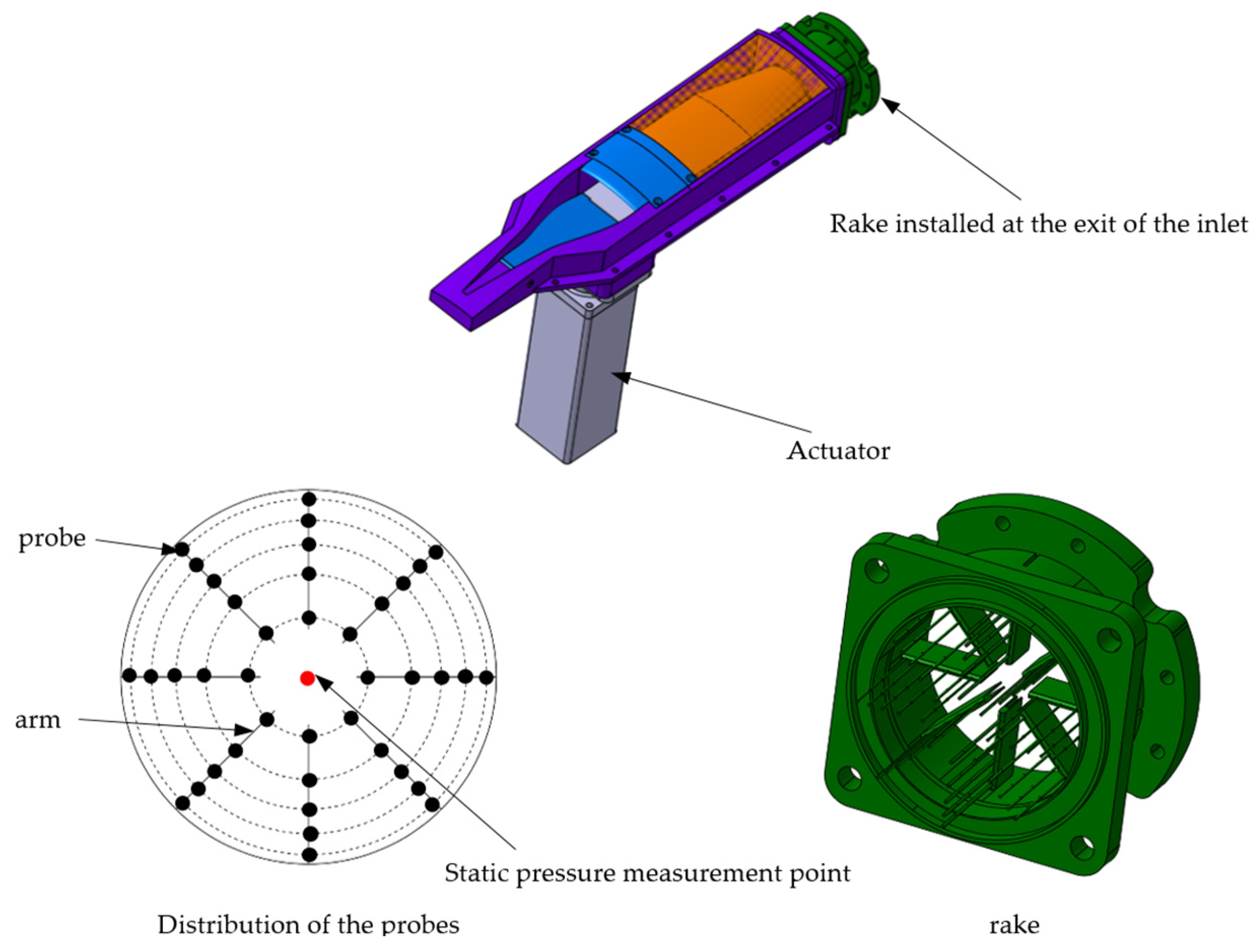
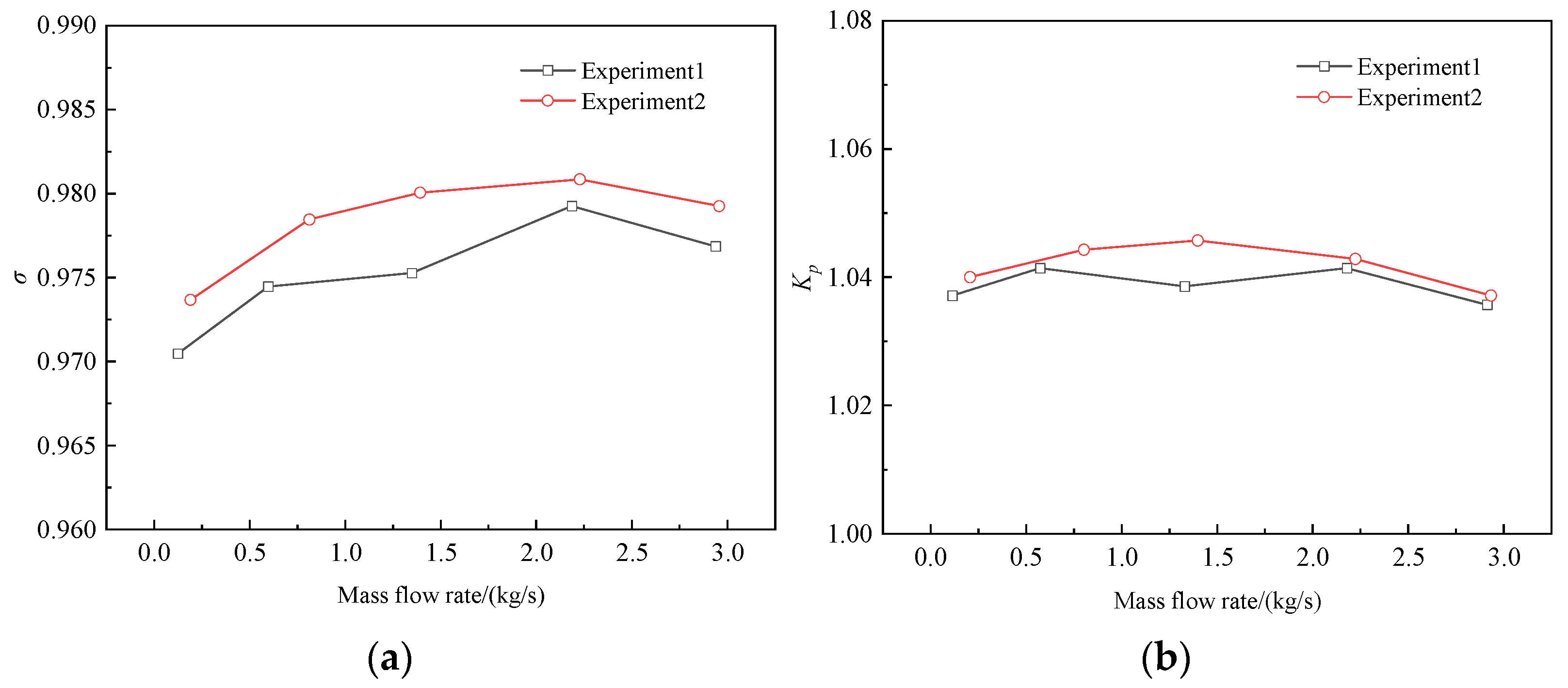



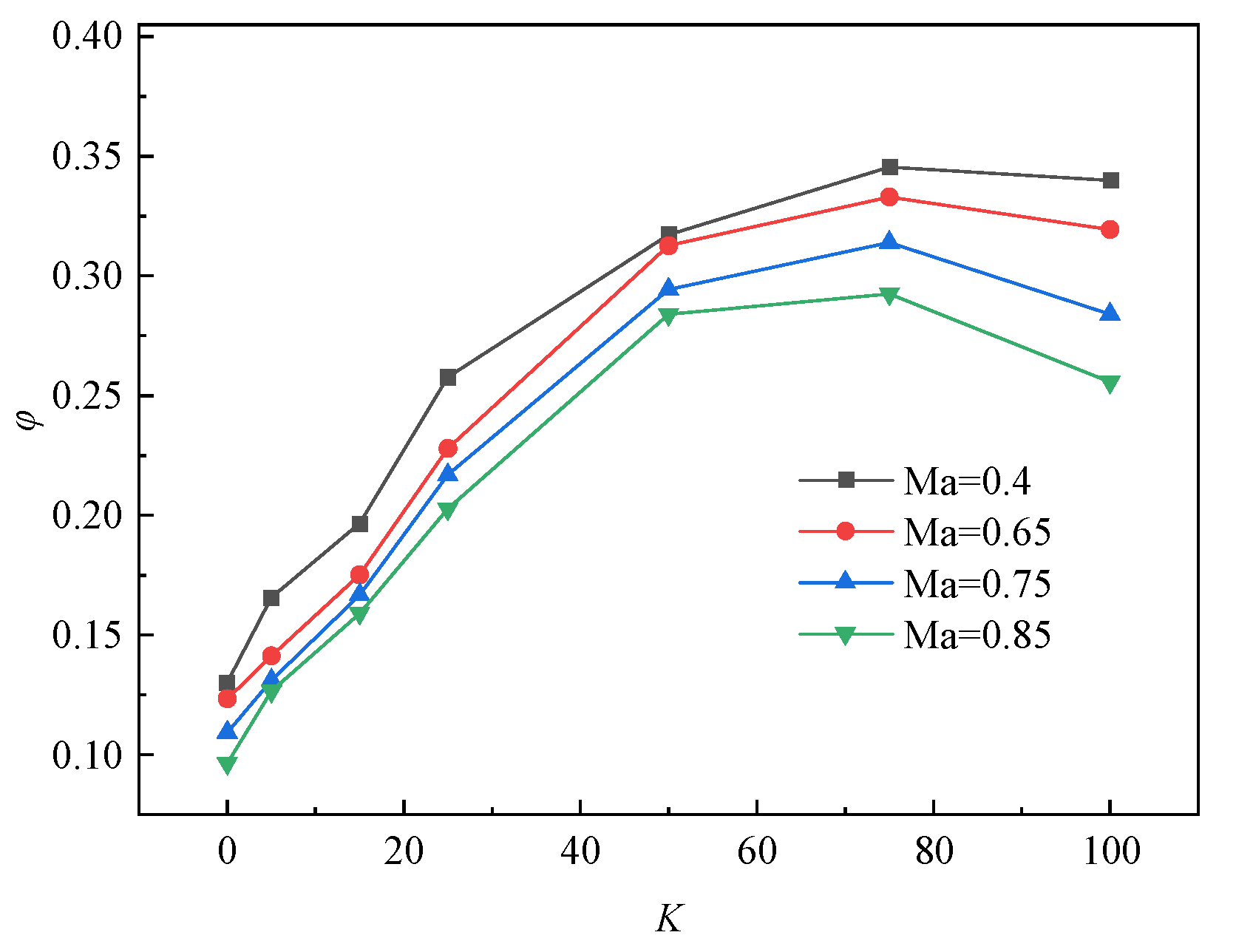
| Cells Number | Mass Flow Rate kg/s | Difference | Max Vorticity ×107 s−1 | Difference |
|---|---|---|---|---|
| 10 million | 2.682 | \ | 1.0502 | \ |
| 15 million | 2.713 | 1.2% | 1.0613 | 1.1% |
| 20 million | 2.725 | 0.4% | 1.0678 | 0.6% |
| 25 million | 2.743 | 0.6% | 1.0704 | 0.2% |
| 30 million | 2.763 | 0.7% | 1.0776 | 0.6% |
Disclaimer/Publisher’s Note: The statements, opinions and data contained in all publications are solely those of the individual author(s) and contributor(s) and not of MDPI and/or the editor(s). MDPI and/or the editor(s) disclaim responsibility for any injury to people or property resulting from any ideas, methods, instructions or products referred to in the content. |
© 2023 by the authors. Licensee MDPI, Basel, Switzerland. This article is an open access article distributed under the terms and conditions of the Creative Commons Attribution (CC BY) license (https://creativecommons.org/licenses/by/4.0/).
Share and Cite
Li, Z.; Liu, M.; Jiang, Y.; Pei, H. Numerical Simulation and Wind Tunnel Test of a Variable Geometry Auxiliary Inlet for a Wide-Body Aircraft Environmental Control System. Appl. Sci. 2023, 13, 5253. https://doi.org/10.3390/app13095253
Li Z, Liu M, Jiang Y, Pei H. Numerical Simulation and Wind Tunnel Test of a Variable Geometry Auxiliary Inlet for a Wide-Body Aircraft Environmental Control System. Applied Sciences. 2023; 13(9):5253. https://doi.org/10.3390/app13095253
Chicago/Turabian StyleLi, Zhimao, Meinan Liu, Yanlong Jiang, and Houju Pei. 2023. "Numerical Simulation and Wind Tunnel Test of a Variable Geometry Auxiliary Inlet for a Wide-Body Aircraft Environmental Control System" Applied Sciences 13, no. 9: 5253. https://doi.org/10.3390/app13095253





